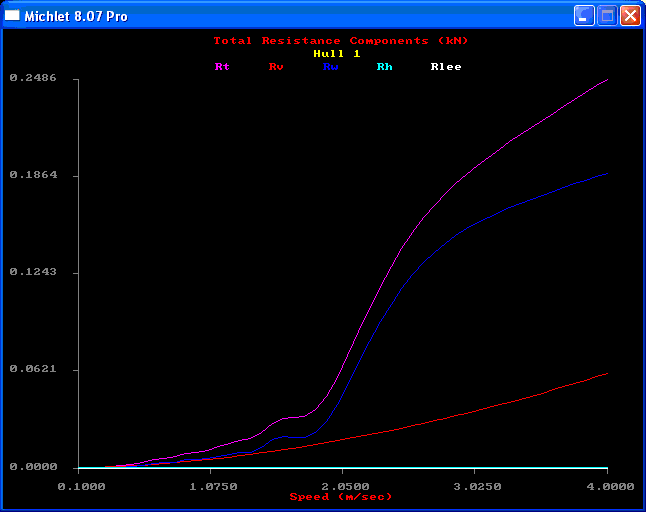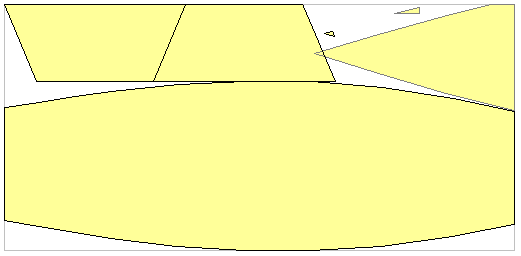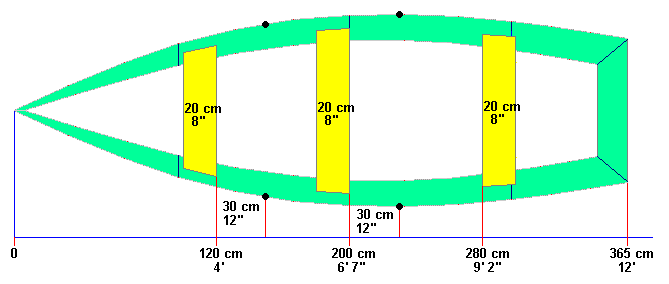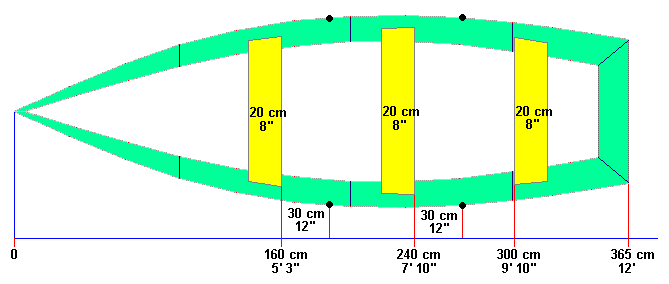

Yet another way of chopping up two sheets of plywood, to come up with a very easy-to-build, yet good looking and versatile 12 ft skiff.
This skiff follows the lines and building methods initially set up in the plans and building instructions for the Portuquese Style Dinghy and later in the 10 1/2 ft Skiff.
The design and building method is basically the same.
A 12 ft skiff is about the maximum You can get out of two sheets of plywood, and
still have the traditional skiff looks. Cutting the plywood for this boat You will
be using about 91 % of the surface area of two sheets of plywood. Very little waste,
that is. Hardly enough for a pair of oar blades.
That's called "economical and ecological use of material" :-)
So, materialwise You couldn't get much more out of two sheets of plywood.
Here's the .hul file for this skiff.

The sides are cut out of one sheet of 1/4" plywood. Both sides will have one butt seam.
The plywood sheet standard in the following pictures is 122 cm x 244 cm = 48" x 96" = 4' x 8'. There are other "standard" plywood sizes, too, but this is probably the most common standard.

The transom and bottom are cut out of the other sheet. The transom is laminated out
of two identical pieces, to get a stiffer result.
The bottom will have one butt seam, and needs to be patched at the very bow and on one
side forward of the butt seam. Small pieces of plywood can be used for the patches,
the patched locations will end up under the chine glassfiber tapings, so they won't
be visible in the finished boat.

Measurements for the sides.

And measurements for the frames and the transom.

The angle of the bow is 50 degrees, so cut the stem piece accordingly.

 |
|
Rt (violet curve) = total resistance
Rv (red curve) = viscous resistance (friction)
Rw (blue curve) = wave forming resistance
Rh (pale blue curve) = resistance created by transom stern
Full speed scale = 4.0 m/s = 14.4 km/h = 9.0 mph = 7.8 knots
The lengthwise balance point of the boat is at the mid frame B, so
if the boat is mainly going to be used by a single person, the
best location for the "main" rowing seat is with the seat rear edge
at the mid frame location.
A possible front rowing seat, and a rear passenger seat are suggested.
These can be used with a crew of two.
The problem with this seating arrangement is that the optimum oar lengths are different for the main and front rowing positions. The optimum length for the main position is 225 cm / 7.5 ft, and 195 cm / 6.5 ft for the front position.

Another possible seating arrangement, where there are two rowing seats
with identical optimum oar lengths. When rowing alone the front seat
would be best when rowing against the wind, the middle seat would be
best rowing with the wind or in sidewind.
The optimum oar length in this case is 210 cm / 7 ft.
